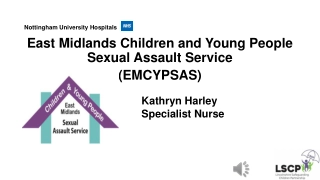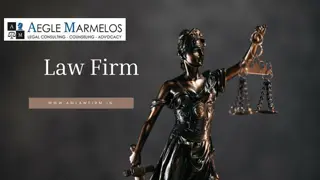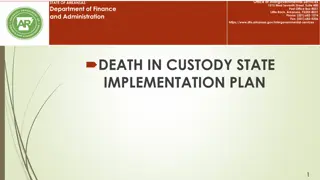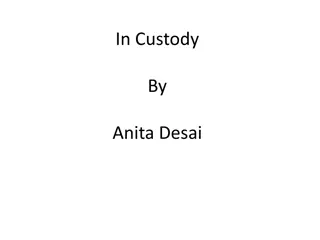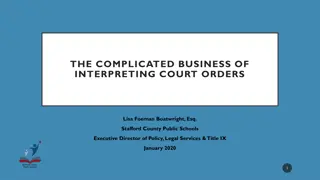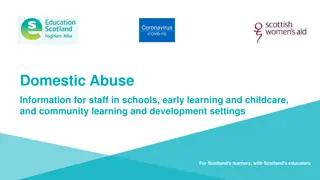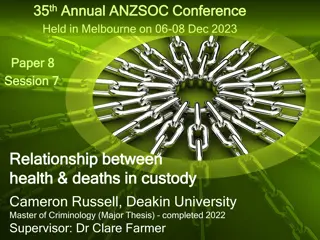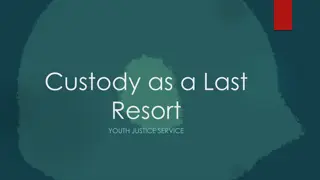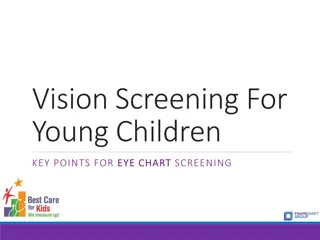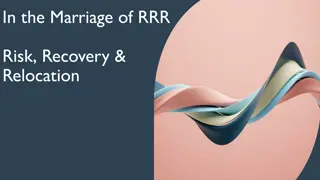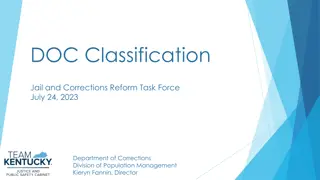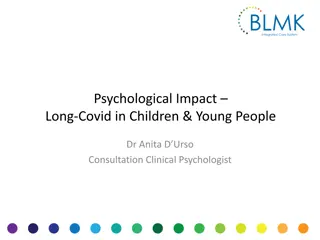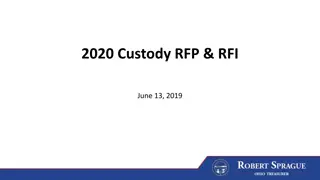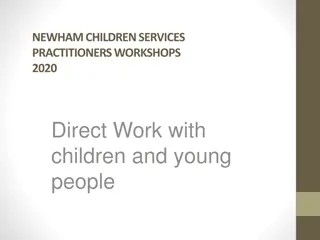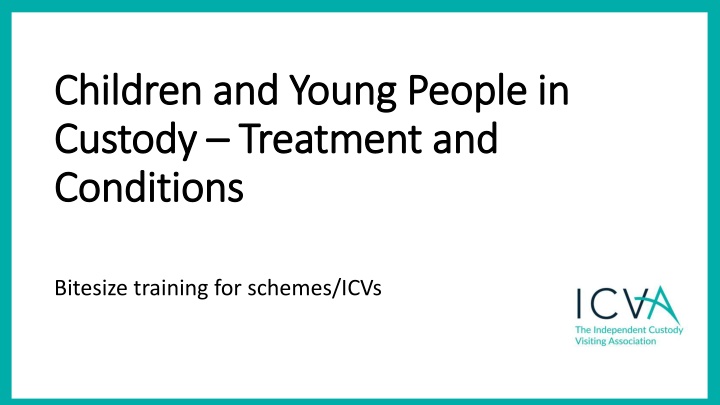
Custody Treatment and Conditions for Children and Young People
Explore legal entitlements, considerations, and differences in treatment and conditions for children and young people in custody. Learn about defining a child, legal rights, and the importance of specialized care in this informative training.
Download Presentation

Please find below an Image/Link to download the presentation.
The content on the website is provided AS IS for your information and personal use only. It may not be sold, licensed, or shared on other websites without obtaining consent from the author. If you encounter any issues during the download, it is possible that the publisher has removed the file from their server.
You are allowed to download the files provided on this website for personal or commercial use, subject to the condition that they are used lawfully. All files are the property of their respective owners.
The content on the website is provided AS IS for your information and personal use only. It may not be sold, licensed, or shared on other websites without obtaining consent from the author.
E N D
Presentation Transcript
Children and Young People in Children and Young People in Custody Custody Treatment and Treatment and Conditions Conditions Bitesize training for schemes/ICVs
Scheme Managers Scheme Managers you have a choice of delivery you have a choice of delivery methods for this training: methods for this training: You are welcome to adapt the slides and deliver the training yourself You are welcome to adapt the slides and deliver the training yourself please use the slide pack as you wish. please use the slide pack as you wish. OR OR ICVA has recorded the session as a straight to ICVs ICVA has recorded the session as a straight to ICVs resource and you can email this video out to your resource and you can email this video out to your ICVs if you would like to by using this link: ICVs if you would like to by using this link: https://youtu.be/mrHRCCJUY https://youtu.be/mrHRCCJUY- -k k
Objectives Objectives 1. To briefly refresh the legal entitlements of children in custody in terms of conditions and treatment. 2. To consider how custody conditions and treatment might vary for children and young people.
How do PACE Codes C and H define a child? How do PACE Codes C and H define a child? 1.5 Anyone who appears to be under 18, shall, in the absence of clear evidence that they are older, be treated as a juvenile for the purposes of this Code and any other Code. There is a specific rights and entitlements leaflet for young people in custody you can access it by putting young people in custody rights and entitlements into Google, or ask your scheme manager and ICVA can send them the link.
What are the legal considerations for children and young What are the legal considerations for children and young people? people? Children/young people must be kept apart from adults in holding rooms and cells. Girls must have a female member of staff. Children/young people must have an AA. Children/young people also have the right to free legal advice, medical assistance and not to be held incommunicado.
Why should treatment and conditions be different for Why should treatment and conditions be different for children and young people? children and young people? Children are a distinct group. All other parts of the criminal justice system have a distinct approach for children other than police custody. Children might be frightened, be less able to understand what is happening to them and be less able to cope with the material conditions of police custody than adults would be able to. Children are likely to want to get out of custody as soon as they can, this may affect behaviours and choices throughout their time in detention.
How could treatment and conditions be different for How could treatment and conditions be different for children and young people? children and young people? Time out of cell: Do the custody staff let children/young people go to the exercise area if the suite has one? Are children/young people able to sit in an empty interview room or other space with their parent/appropriate adult to break up time in cell? Has the child/young person been able to have a shower? If so, are the arrangements explained so that they are aware that their dignity will be preserved, including what can and cannot be observed or seen by staff.
How could treatment and conditions be different for How could treatment and conditions be different for children and young people? children and young people? Visits: The Authorised Professional Practice from the College of Policing (APP) states the following: Children and vulnerable adults likely to be detained for over 24 hours (or overnight) should have the opportunity to have visits from parents or carers.
How could treatment and conditions be different for How could treatment and conditions be different for children and young people? children and young people? Talking to children/young people: Are the staff using empathy and avoiding patronising the child/young person? Are the staff using appropriate humour (not laughing at/mocking the child/young person even if thought to be humour)? Are the staff understanding that children/young people who are frightened might behave aggressively? Are they taking effective steps to de-escalate any aggressive behaviour?
How could treatment and conditions be different for How could treatment and conditions be different for children and young people? children and young people? Food and Drink Anecdotally children and young people are less likely to drink tea, coffee and water than adults in custody. They may be less likely to eat the boxed microwave meals. Some custody suites have stocks of drinks specifically for children and young people such as squash, hot chocolate etc. Does your suite have these? Are they offered proactively to children/young people? Some custody suites have sandwiches or pasties available for detainees, other suites, subject to risk might allow a parent/guardian to bring in food for the child/young person.
How could treatment and conditions be different for How could treatment and conditions be different for children and young people? children and young people? Clothing Lots of young people take pride in their clothing and how they look. Removing the cord from a hooded top could damage it. Subject to risk, is a young person able to keep clothing with cords? If not, has an alternative warm item been offered such as a custody jumper and a blanket and the hooded top put in with the detainee's property as an alternative to cutting cords? If risk allows, is a young person able to keep laces in their shoes/trainers or been offered replacement footwear so that the laces don t have to be removed?
How could treatment and conditions be different for How could treatment and conditions be different for children and young people? children and young people? In cell - distraction items Some custody suites have distraction items for use with children and young people. These include things like foam footballs, jigsaws and mindful colouring books for adults. A custody sergeant who has been responsible for their introduction in her area and others, comments: The effect distraction items have in custody is to bring down anxiety and irritability levels ensuring that young people can better engage with the process and support services within custody, like health care and mental health professionals. Therefore, reducing the likelihood that they will re-enter the custody system and reducing the trauma they are likely to be caused whilst being detained.
ICVs ICVs - - What to look for What to look for Treatment and Conditions Treatment and Conditions Check on all rights and entitlements as you usually would, (contact someone, access to healthcare, solicitor etc.) Is the child being held away from adults where possible? If the child is a girl or young woman, is she in the care of a female member of staff? Has the child or young person been able to spend time out of cell? Has the child or young person been offered specific food and/or drinks that they might be more familiar with? Has the child or young person been given any additional things such as distraction items?
ICVs ICVs - - What to report on What to report on A Checklist A Checklist Treat children as vulnerable note the number in custody. Consider prioritising visits to them. Check rights & entitlements as normal. Note any areas of good practice from custody staff in terms of varied arrangement for children and young people. Check custody record, with permission. Remember: If something feels wrong report it! If something feels good report it!
Children and Young People Children and Young People Other Resources Other Resources ICVA has produced a range of resources on the theme this year, please do ask your scheme manager for links/self study packs for the following if of interest! Children's Concordat We have produced a video for ICVs with Katie Kempen, ICVAs CEO and Jen Twite, a barrister and Head of Strategic Litigation for Just for Kids Law. Children and Young People The Law This bitesize is for ICVs to study at home and comes with a pack of additional resources. Children and Young People The Research This is a video bitesize, covering Dr Miranda Bevans research into children in custody. Children and Young People Hints and Tips This is a short briefing for ICVs on engaging with this group in custody.
Objectives Objectives 1. To briefly refresh the legal entitlements of children in custody in terms of conditions and treatment. 2. To consider how custody conditions and treatment might vary for children and young people.

